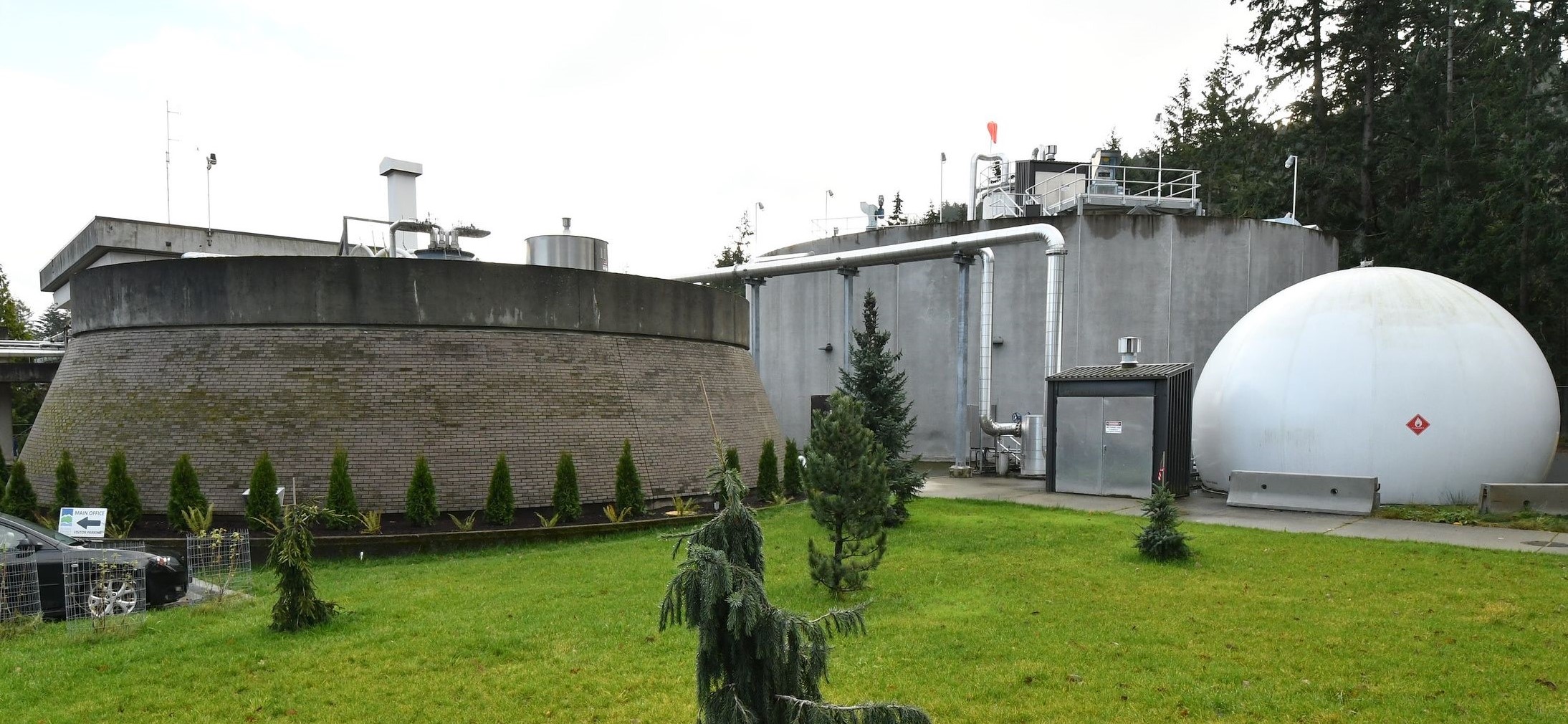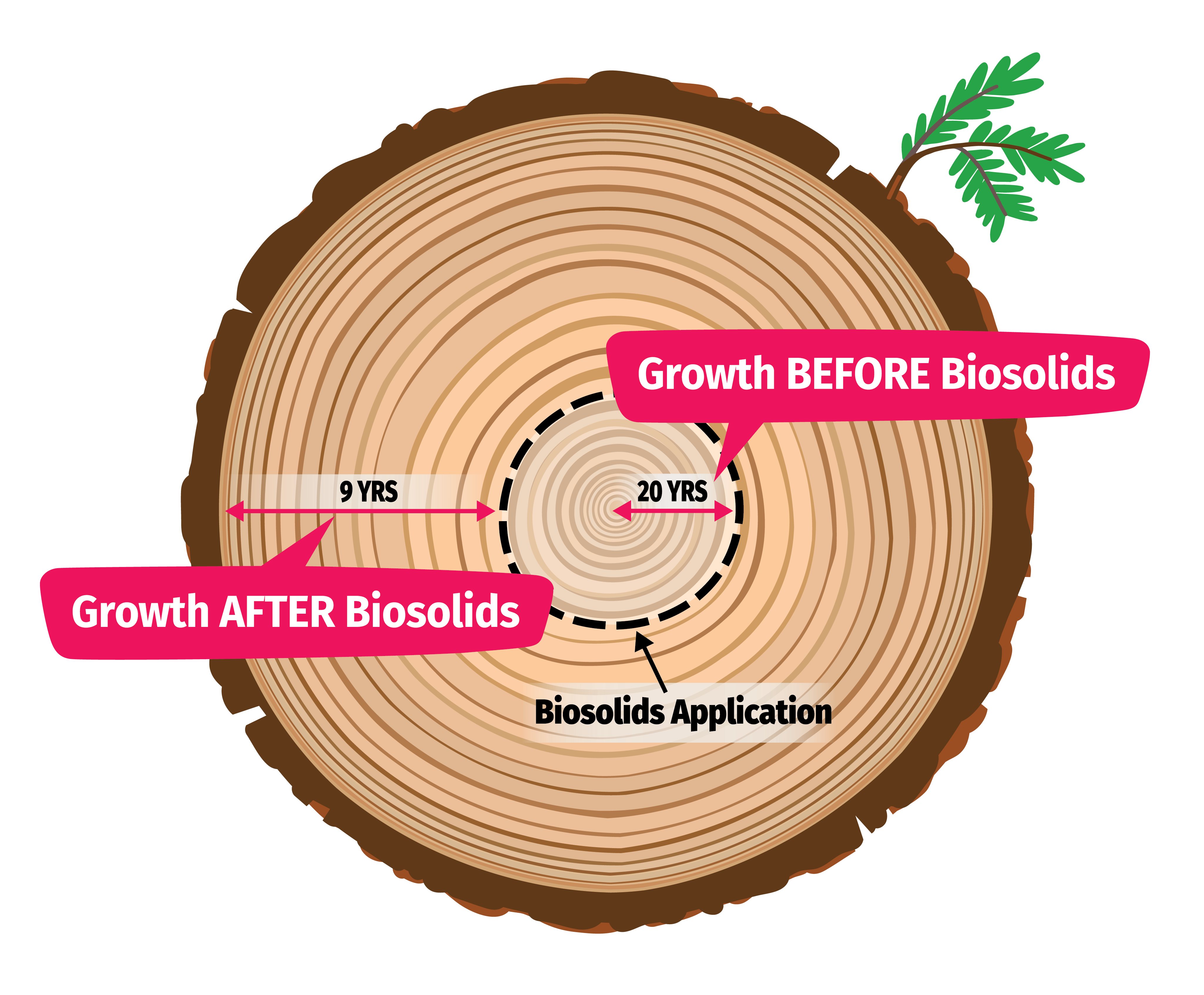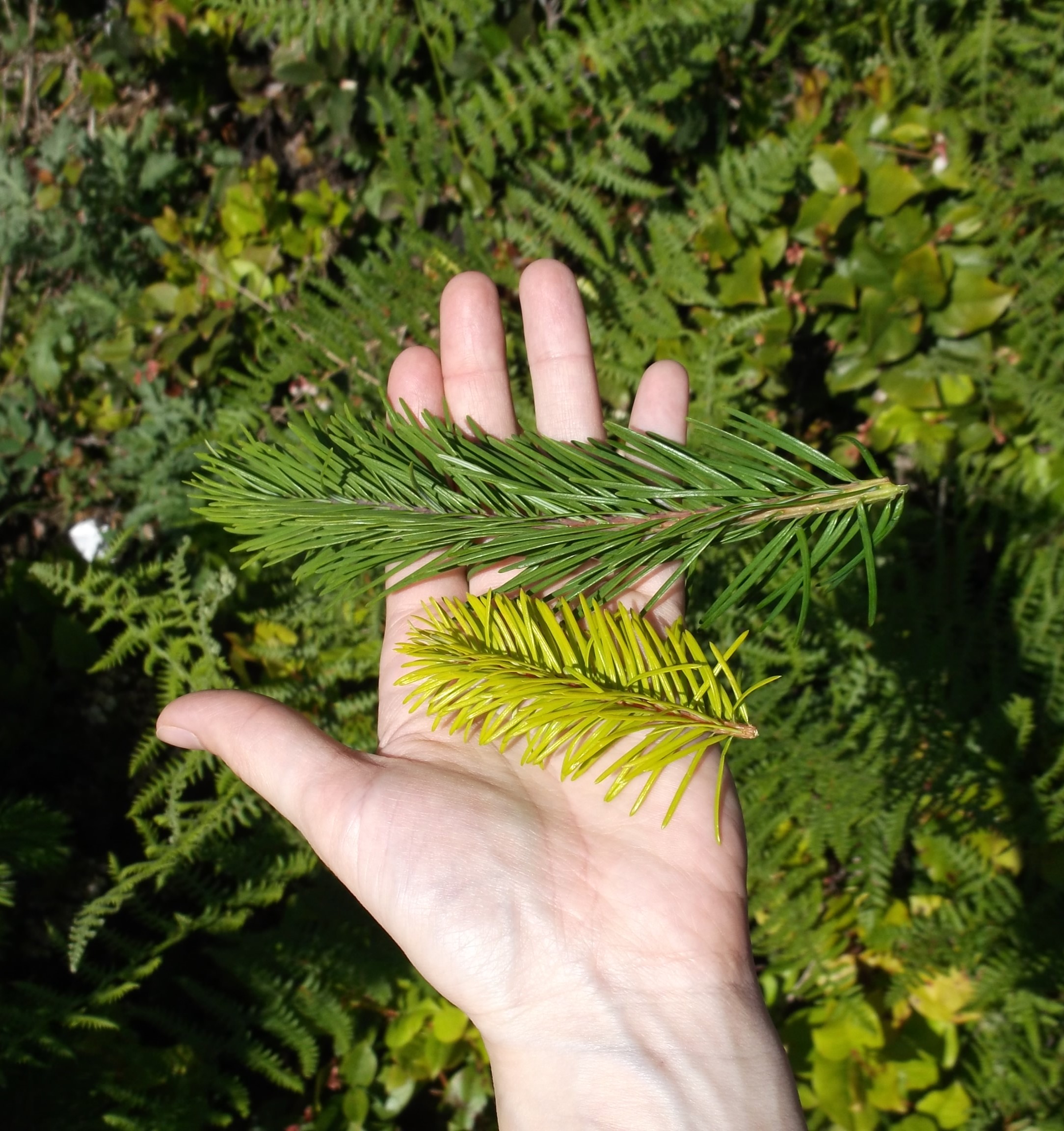Biosolids Management
 The two tanks on the left and in the center of the photo are digesters that produce biosolids at GNPCC
The two tanks on the left and in the center of the photo are digesters that produce biosolids at GNPCCBiosolids are the solid end product of wastewater treatment. They are nutrient-dense organic material with a hummous-like texture similar to compost. The Canadian Council of Ministers of the Environment (CCME) and the BC Ministry of Environment and Parks promote the use of biosolids to benefit from the high nutrient value. The Liquid Waste Management Plan also commits the Regional District of Nanaimo to beneficially using biosolids.
Award-Winning Programs
The RDN produces about 7,000 tonnes of biosolids each year. The RDN has a two-time, award-winning biosolids management program. Currently, RDN biosolids are managed in two reuse programs.
Forest Fertilization Program
Through this program, biosolids are used to increase tree growth on nutrient-poor timberland. This is done while coordinating land use with forestry operations and recreational activities. This program manages biosolids from the Greater Nanaimo Pollution Control Centre (GNPCC) and serves as a contingency site for biosolids from the French Creek Pollution Control Centre (FCPCC).
Check out this Focus on Forest Fertilization sheet for more information.
Soil Fabrication Program
This program operates in partnership with Nanaimo Forest Products Ltd. to fabricate soil at the Harmac Mill in Duke Point.
Check out this Focus on Soil Fabrication sheet for more information.
Frequently Asked Questions
Beneficial Reuse
What are the benefits of reusing biosolids?
Using biosolids has many benefits, including:
-
Replacing the need for fertilizers, which require a lot of energy to produce.
-
Helping meet carbon emission reduction targets: biosolids return carbon back to the soil and help trees grow bigger, faster which pulls even more carbon from the atmosphere.
-
Increasing a soil’s water-holder capacity: biosolids have a high organic matter content that decrease run-off and soil erosion and helps plants thrive during periods of drought.
-
Releasing nutrients slowly, providing a sustained source of nutrients for many years.
-
Returning nutrients to the land: biosolids contain nitrogen, phosphorus, potassium, and other macro and micronutrients essential for healthy plant growth.
How do other jurisdictions manage their biosolids?
A report of Biosolids Management Options Used in Other Jurisdictions was presented to the RDN Board on March 22, 2022.
Biosolids Production and Regulation
How are biosolids different from wastewater sludge?
Biosolids are different than sludge. Sludge is the term for solids that settle during the wastewater treatment process. Biosolids are produced by taking solids treatment a couple of steps further:
- Solids are stabilized at set temperatures for specific lengths of time in engineered tanks called "digesters"
-
Stabilized solids are then dewatered
Stabilized solids can only be called "biosolids" once they meet quality standards outlined in the Provincial Organic Matter Recycling Regulation.
What quality standards do biosolids need to meet?
Biosolids are treated to standards in the Organic Matter Recycling Regulation. Microorganisms and trace elements are two common areas of interest when questions arise about biosolids quality.
Microorganisms: Treatment in RDN digesters kills more than 99 per cent of the microorganisms in biosolids; the rest die off naturally once they are exposed to sunlight and cooler temperatures in the soil.
Trace elements: Trace elements can enter the wastewater collection system from residences, businesses, and stormwater runoff. Many of these trace elements are micronutrients and benefit plant growth, but they can be harmful in excess concentrations. Trace elements in biosolids are carefully monitored. Some trace elements are typically found at lower concentrations in biosolids than in the soils to which they are applied.
What controls are in place to protect public health and the environment?
Public health and the environment are protected in the management of biosolids. The wastewater treatment process mimics the natural breakdown of wastes. When microorganisms "digest" the solid material, they reduce volatile organics and pathogen concentrations.
Biosolids land applications are carried out according to a Land Application Plan which must meet all requirements set out in the Organic Matter Recycling Regulation. The Land Application Plan is also provided to the Ministry of Environment and Parks and Island Health.
The Land Application Plan contains details including soil quality, biosolids quality, biosolids management details, and site-specific management methods. Additional information is also gathered on nearby water features, well locations, and nearby residences.
To protect public health and the environment, we:
- Regularly test our biosolids to ensure they meet regulatory criteria for land application
- Restrict public access to application areas
- Respect setback distances to water bodies, property boundaries, and public roads
- Post signs on roads and paths advising the public that biosolids are being applied
- Regularly monitor surface water at the site.
Forest Fertilization
Where is the Forest Fertilization Program located?
The RDN Forest Fertilization Program is located on private forest lands managed by Mosaic Forest Management, near an area known as Blackjack Ridge, shown on this map of forest fertilization areas.
How does biosolids fertilization improve tree growth and health?
RDN biosolids are applied to nutrient-poor forest stands with rocky soils. Even though we live in a rainy climate, these forest stands are often classified as "very dry" because of the naturally low soil organic matter and summer drought conditions. Biosolids help trees to achieve their maximum natural potential through promoting more ideal site conditions. The biosolids Forest Fertilization Project has demonstrated increases in tree growth. Trees fertilized with biosolids also appear healthier: needles and buds are longer, greener, and more numerous.


How are biosolids stored and applied?
Biosolids are trucked to storage sites within the fertilization area. Biosolids storage facilities at the forest fertilization site are paved, walled on three sides, and covered during the rainy season. Once enough is stored, the biosolids are loaded into a specialized biosolids application vehicle. The vehicle has a large box which feeds the biosolids into a high-speed side throw fan.
The biosolids are carefully applied according to a Land Application Plan. Biosolids are applied to pre-selected application areas at an average depth of 1 cm, a rate which supplies nutrients required by soil organisms, understory vegetation, and trees.
Where are biosolids permitted to go?
The production, distribution, storage, sale and use, or land application of biosolids are strictly regulated by the Organic Matter Recycling Regulation. We regularly test our biosolids to ensure they meet regulatory criteria for land application. Biosolids land applications are restricted to:
- Suitable forest stands
- Suitable weather conditions (biosolids are not applied during heavy rain, over snow, or onto frozen ground)
- Suitable slopes
Biosolids are not applied within specified setback distances from water bodies, property boundaries, and public roads. Public access is restricted in the application areas through locked gates and signage. Signage is posted at entry points and along select trails advising the public that biosolids are applied. We monitor surface water at the biosolids application site.
Will forest fertilization affect our drinking water?
Surface Water
- Biosolids are applied outside of a 30 m setback from waterbodies, meaning there is a very low risk of biosolids entering surface water.
- The RDN forest fertilization program operates in a distinctly separate watershed from the City of Nanaimo drinking water supply area.
Groundwater
- Once applied, biosolids only travel about 5-10 cm through the soil matrix, the typical length of a pencil. This means that it is very unlikely that biosolids will enter groundwater, aquifers, or well water, or travel far from where they are applied through wind or water movement.
- Assessments carried out in 2003 and 2012 concluded that past and proposed future applications of biosolids within the Forest Fertilization Application Area will not impact groundwater quality in any of the wells located in the region.
Will access to the forest be restricted during or after biosolids applications?
The RDN's biosolids forest fertilization project is located on private land and access is restricted. Notification signs are posted at locations of biosolids fertilization.
Where else has this type of project been done?
Biosolids have been widely used in Canada, the United States, Europe, and across the world for over 70 years. In BC, the most common uses are as a feedstock in composting or soil fabrication, followed by beneficial use in agriculture, mine reclamation, and forestry. Metro Vancouver has completed forest fertilization projects throughout the province following early work in collaboration with the University of British Columbia demonstrating the potential for using biosolids as a forest fertilizer. Seattle, Washington has over 30 years of experience fertilizing forests with biosolids.
What reports are available?
Annual Summary of RDN Biosolids Management:
- 2024 Annual Summary of GNPCC Biosolids Management
- 2024 Annual Summary of FCPCC Biosolids Management.
Surface Water
Surface water quality summaries conclude that it is unlikely that biosolids application at the forest fertilization site are having an adverse effect on surface water quality.
- 2019 Surface Water Quality Study
- 2018 Surface Water Quality Study
- 2012-2017 Surface Water Quality Study.
Groundwater
In 2003 and 2012, groundwater impact assessments were carried out. They concluded that past and proposed future application of biosolids within the Biosolids Application Area will not impact groundwater quality in any of the wells located in the region. This confirmed previous monitoring results from 1992 that showed biosolids had:
- No measurable impact on ground water
- No measurable impact on nearby surface waters
- No detectable impact on the five nearest residential water wells.